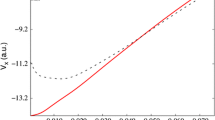Abstract
Atomic effective one-electron potentials in a compact analytic form in terms of a few Gaussian charge distributions are developed, for hydrogen through nobelium, for starting molecular electronic structure calculations by a simple diagonalization. For each element, all terms but one are optimized in an isolated-atom Hartree–Fock calculation, and the last one is parametrized on a set of molecules. This one-parameter-per-atom model gives a good starting guess for typical molecules and may be of interest even on its own.
Similar content being viewed by others
Notes
To be found at https://github.com/briling/aepm.
References
Hoffmann R (1963) J Chem Phys 39:1397. https://doi.org/10.1063/1.1734456
King HF, Stanton RE, Kim H, Wyatt RE, Parr RG (1967) J Chem Phys 47:1936. https://doi.org/10.1063/1.1712221
Schmidt MW, Baldridge KK, Boatz JA, Elbert ST, Gordon MS, Jensen JH, Koseki S, Matsunaga N, Nguyen KA, Su S, Windus TL, Dupuis M, Montgomery JA (1993) J Comput Chem 14:1347. https://doi.org/10.1002/jcc.540141112
Huzinaga S, Andzelm J, Klobukowski M, Radzio-Andzelm E, Sakai Y, Tatewaki H (1984) Gaussian basis sets for molecular calculations, vol 16. Physical sciences data. Elsevier, Amsterdam
Sharp RT, Horton GK (1953) Phys Rev 90:317. https://doi.org/10.1103/physrev.90.317
Talman JD, Shadwick WF (1976) Phys Rev A 14:36. https://doi.org/10.1103/physreva.14.36
Maldonado P, Sarsa A, Buendía E, Gálvez F (2011) Atom Data Nucl Data 97:109. https://doi.org/10.1016/j.adt.2010.10.002
Kohn W, Sham LJ (1965) Phys Rev 140:A1133. https://doi.org/10.1103/PhysRev.140.A1133
Harris J (1985) Phys Rev B 31:1770. https://doi.org/10.1103/physrevb.31.1770
Becke AD (1988) J Chem Phys 88:2547. https://doi.org/10.1063/1.454033
Laqua H, Kussmann J, Ochsenfeld C (2018) J Chem Phys 149:204111. https://doi.org/10.1063/1.5049435
Lehtola S (2019) J Chem Theory Comput 15:1593. https://doi.org/10.1021/acs.jctc.8b01089
Van Lenthe JH, Zwaans R, Van Dam HJJ, Guest MF (2006) J Comput Chem 27:926. https://doi.org/10.1002/jcc.20393
Amat L, Carbó-Dorca R (2001) Int J Quantum Chem 87:59. https://doi.org/10.1002/qua.10068
Sambe H, Felton RH (1975) J Chem Phys 62:1122. https://doi.org/10.1063/1.430555
Dunlap BI, Connolly JWD, Sabin JR (1979) J Chem Phys 71:3396. https://doi.org/10.1063/1.438728
Slater JC (1951) Phys Rev 81:385. https://doi.org/10.1103/PhysRev.81.385
Dunlap BI (1986) J Phys Chem 90:5524. https://doi.org/10.1021/j100280a010
Laikov DN (1997) Chem Phys Lett 281:151. https://doi.org/10.1016/S0009-2614(97)01206-2
Nazari F, Whitten JL (2017) J Chem Phys 146:194109. https://doi.org/10.1063/1.4983395
Whitten JL (2019) J Chem Phys 150:034107. https://doi.org/10.1063/1.5064781
Whitten JL (2019) Phys Chem Chem Phys 21:21541. https://doi.org/10.1039/c9cp02450f
Boys SF (1950) Proc R Soc A 200:542. https://doi.org/10.1098/rspa.1950.0036
Laikov DN (2019) Theor Chem Acc 138:40. https://doi.org/10.1007/s00214-019-2432-3
Dyall KG (1994) J Chem Phys 100:2118. https://doi.org/10.1063/1.466508
Visscher L, Dyall KG (1997) Atom Data Nucl Data 67:207. https://doi.org/10.1006/adnd.1997.0751
Laikov DN (2019) J Chem Phys 150:061103. https://doi.org/10.1063/1.5082231
Kahn LR, Baybutt P, Truhlar DG (1976) J Chem Phys 65:3826. https://doi.org/10.1063/1.432900
Perdew JP, Burke K, Ernzerhof M (1996) Phys Rev Lett 77:3865. https://doi.org/10.1103/PhysRevLett.77.3865
Laikov DN (2005) Chem Phys Lett 416:116. https://doi.org/10.1016/j.cplett.2005.09.046
Laikov DN (2011) J Chem Phys 135:134120. https://doi.org/10.1063/1.3646498
McMurchie LE, Davidson ER (1978) J Comput Phys 26:218. https://doi.org/10.1016/0021-9991(78)90092-x
Havriliak S, King HF (1983) J Am Chem Soc 105:4. https://doi.org/10.1021/ja00339a002
Wolinski K, Pulay P (2003) J Chem Phys 118:9497. https://doi.org/10.1063/1.1562606
Deng J, Gilbert ATB, Gill PMW (2009) J Chem Phys 130:231101. https://doi.org/10.1063/1.3152864
Deng J, Gilbert ATB, Gill PMW (2010) J Chem Phys 133:044116. https://doi.org/10.1063/1.3463800
Martin J, Baker J, Pulay P (2009) J Comput Chem 30:881. https://doi.org/10.1002/jcc.21106
Author information
Authors and Affiliations
Corresponding author
Additional information
Publisher's Note
Springer Nature remains neutral with regard to jurisdictional claims in published maps and institutional affiliations.
Electronic supplementary material
Below is the link to the electronic supplementary material.
Rights and permissions
About this article
Cite this article
Laikov, D.N., Briling, K.R. Atomic effective potentials for starting molecular electronic structure calculations. Theor Chem Acc 139, 17 (2020). https://doi.org/10.1007/s00214-019-2521-3
Received:
Accepted:
Published:
DOI: https://doi.org/10.1007/s00214-019-2521-3




